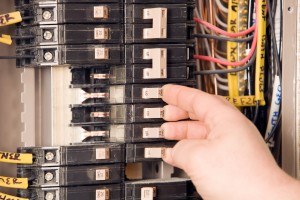 A lot of people won’t plug in their new TV or toaster without reading the instruction booklet at least once. But many will move into a new home without understanding the electrical system that makes all the electronics work. Would you know how to trip the main circuit if someone was being shocked in the bathroom?
A lot of people won’t plug in their new TV or toaster without reading the instruction booklet at least once. But many will move into a new home without understanding the electrical system that makes all the electronics work. Would you know how to trip the main circuit if someone was being shocked in the bathroom?
“Understanding how your home’s electrical system functions is important not only to keep it properly maintained, but for your safety if a problem arises,” said Tom VanParis, CEO of Indiana Electric Cooperatives. “We ask all of our consumers to familiarize themselves with this equipment that keeps their homes running smoothly.”
Your electric cooperative handles the line portion of a consumer’s service, which includes everything up to the attachment point on the house. Everything beyond that point is called the “load side,” and everything on the load side is the consumer’s responsibility.
Your electric cooperative connects the outdoor wires to the meter mounted outside your home. The meter measures the amount of electricity your home uses and determines your bill each month. Tampering with it is both extremely dangerous and illegal.
You’ll find your electrical service panel inside your home. It keeps everything inside running. The service panel sends electricity to the light switches, outlets and appliances. If your electricity short circuits or an overload shuts down power, your service panel is where you will go to restore the flow.
Depending on the age of your home, either fuses or circuit breakers help your home’s electrical system from overloading, thus preventing an electrical fire. The main breaker will cut all power to the home, and the individual circuit breakers administer power to individual parts of the home. If you look in your service panel, all of the circuits and what they power should be labeled. A couple times a year, try turning each breaker on and off. This helps familiarize you with each component of the box and will keep them from getting stuck.
You are responsible for making sure no circuits are overloaded. A general rule when setting up your breakers is to have only one big ticket item on a circuit. That means you would not put your refrigerator and washing machine on the same circuit. If your circuits frequently overload, it may be time to contact an electrician to add more circuits to your service panel.
Once you understand the basic workings of your home’s electrical system, you’ll be able to jump into action if a problem arises.
Source: Electrical Safety Foundation International, Boston Building Resources
Fixing an Overload
Instructions for Replacing Fuses:
Once a fuse is blown, it must be unscrewed and thrown away. When replacing fuses in your service panel:
- Match the replacement fuse with the amperage rating of the circuit.
- Never replace a fuse with one that has a larger amperage rating. This is a very dangerous practice and a serious fire hazard.
Instructions for Resetting a Tripped Breaker:
- Unplug or turn off appliances in the room.
- Find your main breaker panel and open the cover.
- Locate the tripped breaker blown fuse. A tripped circuit breaker will be in the “off” position or in a middle position between “on” and “off.”
- To reset the breaker switch it to “off” position and then back to “on.” If the problem continues, there may be more serious issues. Contact an electrician to identify the problem.
Source: Electrical Safety Foundation International
Electric lingo (260 words)
When you call an electrician to assist you with a problem, it’s helpful to know the lingo. Here are a few electrical terms to know:
Electrical Service Panel: Distributes electricity to switches, outlets and appliances.This is where you can restore the flow to an overloaded circuit or shut down the power to the circuit.
Fuse: Safety devices used to protect individual circuits that were installed in homes before 1965. Everytime a fuse is blown it must be replaced.
Circuit Breakers: Safety devices used to protect individual circuits that are now used in newer homes. When a circuit is “tripped” it just has to be mechanically reset to resume operating.
Arc Fault: A dangerous electrical problem caused by damaged, overheated or stressed electrical wiring or devices.
Arc Fault Circuit Interruptors (AFCIs): AFCIs are new protective devices that replace standard circuit breakers in the electric service panel. AFCIs provide enhanced protection against additional fire hazards known as arc faults.
Tamper Resistant Receptacles (TRRs): A wall outlet that features an internal shutter mechanism which prevents children from sticking objects like hairpins, keys and paper clips into the receptacle.
Ground Fault Circuit Interrupters (GFCIs): Electrical safety devices that trip electrical circuits when they detect ground faults or leakage currents.
Grounding: The method used to connect an electrical system to the earth with a wire. Grounding will help protect the person working on the system, the system itself, and any appliances and equipment that are connected to the system.
Source: Electrical Safety Foundation International



